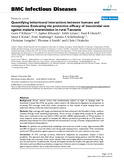Quantifying behavioural interactions between humans and mosquitoes: Evaluating the protective efficacy of insecticidal nets against malaria transmission in rural Tanzania

View/
Date
2006-11-10Author
Killeen, Gerry F
Kihonda, Japhet
Lyimo, Edith
Oketch, Fred R
Kotas, Maya E
Mathenge, Evan
Schellenberg, Joanna A
Lengeler, Christian
Smith, Thomas A
Drakeley, Chris J
Type
Journal ArticleMetadata
Show full item recordAbstract
Abstract
Background
African malaria vectors bite predominantly indoors at night so sleeping under an Insecticide-Treated Net (ITN) can greatly reduce malaria risk. Behavioural adaptation by mosquitoes to increasing ITN coverage could allow vector mosquitoes to bite outside of peak sleeping hours and undermine efficacy of this key malaria prevention measure.
Methods
High coverage with largely untreated nets has been achieved in the Kilombero Valley, southern Tanzania through social marketing programmes. Direct surveys of nightly biting activity by An. gambiae Giles were conducted in the area before (1997) and after (2004) implementation of ITN promotion. A novel analytical model was applied to estimate the effective protection provided by an ITN, based on published experimental hut trials combined with questionnaire surveys of human sleeping behaviour and recorded mosquito biting patterns.
Results
An. gambiae was predominantly endophagic and nocturnal in both surveys: Approximately 90% and 80% of exposure occurred indoors and during peak sleeping hours, respectively. ITNs consistently conferred >70% protection against exposure to malaria transmission for users relative to non-users.
Conclusion
As ITN coverage increases, behavioural adaptation by mosquitoes remains a future possibility. The approach described allows comparison of mosquito biting patterns and ITN efficacy at multiple study sites and times. Initial results indicate ITNs remain highly effective and should remain a top-priority intervention. Combined with recently developed transmission models, this approach allows rapid, informative and cost-effective preliminary comparison of diverse control strategies in terms of protection against exposure before more costly and intensive clinical trials.
URI
http://dx.doi.org/10.1186/1471-2334-6-161http://erepository.uonbi.ac.ke:8080/xmlui/handle/123456789/14775
